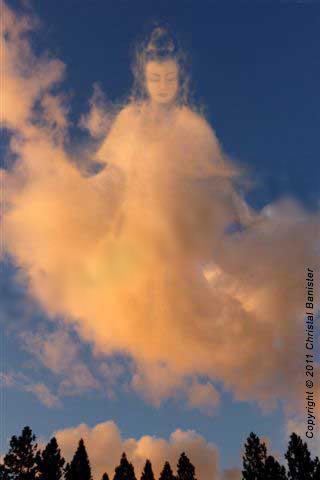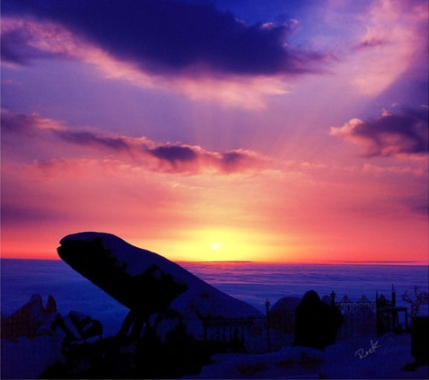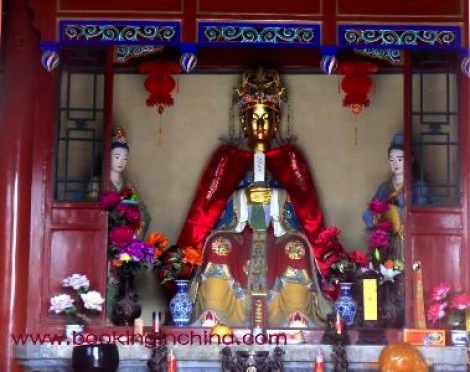“Makar Sankranti’s themes are blessings, offering, mediation, earth, sun, thankfulness, love, passion and abundance. Her symbols are water, light, soil and caves. This is Makar Sankranti’s festival day, Pongol [actually from my research, it currently falls on January 14 – * see note below]. After many months of slumber, this mother Goddess awakens from the earth womb to restore love, abundance, and passion in our lives through sacred rituals, over which She presides.
Pongol is the Hindu word for Winter Solstice. It is a three-day harvest celebration with several ‘borrowable’ traditions that venerate both Makar Sankranti and the holiday. Begin with a ritual cleansing and blessing for your home in any manner suited to your tradition. This keeps relationships strong and banishes sickness. Bathing sacred cows today also brings prosperity. This might translate into washing the image of a cow, your images of the Goddess, or even a special coin to improve financial stability.
In terms of an offering for the Goddess, sweet rice is customary, followed by an afternoon of kite flying so that the burdens in your life will become as light as the wind! For people in four-season climates, it might be too cold for kite flying today, so just release a little of the Goddess’s soil to the wind and ask Her to take your problems away, replacing them with solid relationships and success.”
(Patricia Telesco, “365 Goddess: a daily guide to the magic and inspiration of the goddess”.)
Makar Sankranti is a very popular festival in India and is celebrated in almost all parts of the country in myriad cultural forms, with great devotion, fervour and gaiety. According to Hindu calendar, Makar Sankranti occurs when sun changes its direction northwards from Dhanu Rashi (Sagittarius) to enter the Makar Rashi (Capricorn) in the month of Poush. Makar Sankranti is considered very auspicious day and it is believed any sacred ritual or task can be started or performed on this day and it will be fruitful. It marks the beginning of harvesting season and end of chilly winter season. [1]
Sankranti is also considered a Goddess. According to Ramona Taylor, “there are several legends associated with this very special holiday. One such legend relates to Sankranti, the deity who is linked to the motion of the Sun and the energy derived from the orb. As the tale goes, Sankranti slayed a demon, Sankarasur, on this specific day which is now celebrated as Makar Sankranti. [The next day She slayed the demon Kinkarasur, hence the day is called Kinkrant or Karidin].
Another legend regarding this harvest season holiday relates to Bhishma, the revered demigod born of the River Goddess, Ganga and a king. A gifted archer and devoted soul, Bhishma lived for more than three centuries. In the battlefield of Kurukshetra, the great warrior Bhishma was mortally wounded, but he held onto life until the start of Uttarayana. Once the sun had entered Makar, the great warrior died. It is believed that if a person dies on this day, their soul is released from the birth/rebirth cycle and joins with the Almighty.” [2]
* Note ~ “It is scientifically said that around December 21 – 22 is the shortest day of the year. After that the day span usually gets longer. Hence, Winter Solstice actually begins around this date when the tropical sun moves into the Makar rashi or Capricorn zodiac sign. Thus, the real Uttarayana is on December 21st. Initially, it was considered as the actual date of Makar Sankranti too. However, the earth’s lean of 23.45 degrees caused Makar Sankranti to slither further over the years. History of Makar Sankranti says that almost 1000 years ago it was celebrated on 31st of December. Presently, according to the Hindu Solar calendar, January 14th is the celebration date of Maker Sankranti.” [3]
Sources:
Dhingra, Mamta. Ezinearticles.com, “Makar Sankranti Significance“.
Hindu Janajagruti Samiti. Hindujagruti.org, “Makar Sankranti Festival“.
Jupiter Infomedia Ltd. Indianetzone.com, “History of Makar Sankranti“.
Taylor, Ramona. Voices.yahoo.com, “The Festival of Makar Sankranti“.
Suggested Links:
Hindu Janajagruti Samiti. Hindujagruti.org, “Makar Sankranti Festival” (HIGHLY RECOMMEND! Includes Methods of celebration and Culture & Festivities).
Of-india.com, “Makar Sankranthi – The Winter Festival“.
















